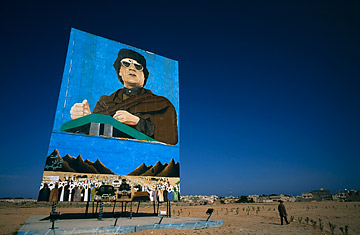
A mural of Gaddafi in Sert
(2 of 2)
Today Sert, which has 135,000 residents in the city and surroundings, has changed dramatically because of government largesse. The town now has reasonably good infrastructure (unlike most other Libyan cities) and sports a university and large hospital, along with numerous government buildings. In fact, all central government ministries — except for foreign affairs — had been ordered to relocate to Sert in order to create a new administrative capital roughly in the middle of the country, between the east, dominated by Benghazi, and the west, dominated by Tripoli. However, bureaucrats with comfortable homes in Tripoli, a city of more than 2 million, managed to defer transfers, and today most ministries have set up only satellite offices in Sert, with the real business of government still taking place in Tripoli.
Gaddafi was more effective setting up Sert as an international showcase, building a huge conference center, the Palais des Congres, the largest such hall in North Africa, and other facilities to host African summits, U.N. meetings and, more recently, the Darfur peace talks. "This is really the political capital of the regime," says Tawil, who has written a book about Islamist groups in North Africa.
Another international touch in Sert: it is thought to have become home to possibly thousands of retired mercenaries from Chad, part of the Islamic Arab Legion Gaddafi funded in the 1980s, according to McGregor.
The real defense of the city, however, would come from the families of two key tribes — Gaddafi's Qadhadfa and the Magariha — many of whose members have been absorbed into Gaddafi's sprawling domestic and military-intelligence services or into key security units.
The question for both the regime and its opponents is whether or not Gaddafi's tribal support frays. Analysts are watching for signs of tribal defections from the regime as the only way to avoid a protracted civil war. There has been some internal grumbling that Gaddafi has already done damage to his tribe's future prospects, with much worse to come if he chooses to go down in a bloodbath. And there have been some Qadhadfa defections, including, most notably, Gaddafi's cousin Ahmed Gadhaf al-Dam, a brigadier general whose multiple responsibilities include commanding forces in the eastern portion of the country that has now successfully detached itself from the regime in Tripoli.
But most experts say the bulk of the Qadhadfa tribe — estimated at 50,000 to 60,000 people — will follow Gaddafi to the end, even though many regarded him as a tribal parvenu who was extraordinarily lucky to have pulled off the 1969 coup against Libya's King Idris. Many other military officers, including some from more prominent tribes, were rumored to have been planning the same at that time. "The Qadhadfa tribe has become so closely enmeshed with the regime — there are so many in intelligence and security services — that they just don't have many other options," says Niblock, a scholar at the University of Exeter.
In a way, if Sert continues to stand as a symbol of loyalty to Gaddafi, the better it is for the regime. Says McGregor, "The people that haven't bolted already are now less likely, by the day, to bolt from the regime. If they see that Gaddafi is able to consolidate his position and is able to actually go on the offensive, then there's not a lot of incentive to take a big chance [and defect]." He adds, "They've been brought up with a very ingrained fear of Gaddafi, and the fact that he's still around a couple of weeks into this has probably got a lot of [them] thinking, well, he could come out on top in the long run here. I mean, this is not the first rebellion he's faced in Libya — and he's still in power."
